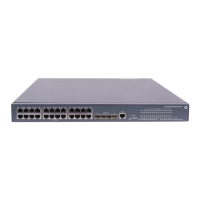81
Ste
Command
Remarks
2. Enter interface view or port
group view.
• Enter Layer 2 Ethernet interface view or
Layer 2 aggregate interface view:
interface interface-type
interface-number
• Enter port group view:
port-group manual port-group-name
Use one of the commands.
3. Configure the maximum rate
of the ports.
stp transmit-limit limit 10 by default.
Configuring edge ports
If a port directly connects to a user terminal rather than another device or a shared LAN segment, this
port is regarded as an edge port. When network topology change occurs, an edge port will not cause
a temporary loop. Because a device does not determine whether a port is directly connected to a
terminal, you must manually configure the port as an edge port. After that, the port can transit rapidly
from the blocked state to the forwarding state.
Configuration restrictions and guidelines
• If BPDU guard is disabled, a port set as an edge port will become a non-edge port again if it
receives a BPDU from another port. To restore the edge port, re-enable it.
• If a port directly connects to a user terminal, configure it as an edge port and enable BPDU guard
for it. This enables the port to transit to the forwarding state quickly while ensuring network security.
• You cannot configure edge port settings and loop guard on a port at the same time.
Configuration procedure
To specify a port or a group of ports as edge port or ports:
Ste
Command
Remarks
1. Enter system view.
system-view N/A
2. Enter interface view or port
group view.
• Enter Layer 2 Ethernet interface view or
Layer 2 aggregate interface view:
interface interface-type
interface-number
• Enter port group view:
port-group manual port-group-name
Use one of the commands.
3. Configure the current ports as
edge ports.
stp edged-port enable
All ports are non-edge ports
by default.
Configuring path costs of ports
Path cost is a parameter related to the rate of a port. On a spanning tree device, a port can have different
path costs in different MSTIs. Setting appropriate path costs allows VLAN traffic flows to be forwarded
along different physical links, achieving VLAN-based load balancing.

